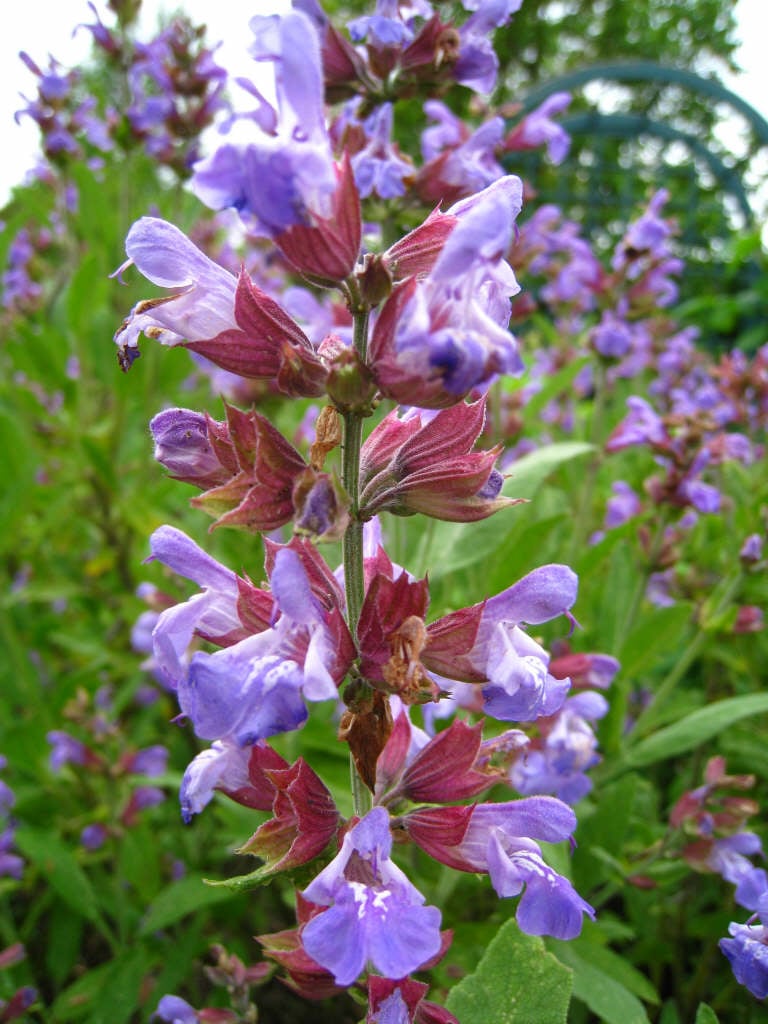Salvia officinalis
common sage
A bushy, spreading evergreen sub-shrub to 75cm tall, with very aromatic, finely veined, grey-green, oblong leaves to 6cm long and 2.5cm wide and short spikes of pale blue flowers in early summer. Fresh and dried leaves are used as a popular culinary herb. There are many cultivated varieties of sage available, varying in size, strength and leaf-colour. 'Purpuracens' has attractive purple foliage. 'Tricolor' has grey-green with cream-variegated leaves that are flushed with purple on young growth and 'Icterina' has yellow-variegated, pale green leaves
Synonyms
Salvia officinalis 'Greek'
Buy this plant
Size
Ultimate height
0.5–1 metresTime to ultimate height
2–5 yearsUltimate spread
0.5–1 metresGrowing conditions
Moisture
Moist but well–drained, Well–drainedpH
Acid, Alkaline, NeutralColour & scent
| Stem | Flower | Foliage | Fruit | |
| Spring | Green Grey Silver | |||
|---|---|---|---|---|
| Summer | Blue | Green Grey Silver | ||
| Autumn | Green Grey Silver | |||
| Winter | Green Grey Silver |
Position
- Full sun
Aspect
South–facing or West–facing
Exposure
Sheltered Hardiness
H5Botanical details
- Family
- Lamiaceae
- Native to GB / Ireland
- No
- Foliage
- Evergreen
- Habit
- Bushy
- Genus
Salvia can be annuals, biennials, herbaceous or evergreen perennials, or shrubs. They have paired, simple or pinnately lobed, often aromatic leaves and 2-lipped flowers in whorls, forming simple or branched spikes or racemes
- Name status
Correct
- Plant range
- Mediterranean, Africa
How to grow
Cultivation
Thrives in a sunny spot, in moderately fertile soil with good drainage. Drought tolerant once established. Protect from excess winter wet. See sage cultivation
Propagation
Propagate by by seed sown in spring or by softwood cuttings in early summer
Suggested planting locations and garden types
- City and courtyard gardens
- Coastal
- Cottage and informal garden
- Patio and container plants
- Mediterranean climate plants
- Gravel garden
- Wall side borders
- Flower borders and beds
Pruning
Pruning group 9 in spring. Cut back flower spikes after flowering to keep plants compact
Pests
May be susceptible to rosemary beetle, sage leafhopper and capsid bug
Diseases
May be susceptible to honey fungus (rarely), powdery mildews, verticillium wilt and foot and root rots
Get involved
The Royal Horticultural Society is the UK’s leading gardening charity. We aim to enrich everyone’s life through plants, and make the UK a greener and more beautiful place.